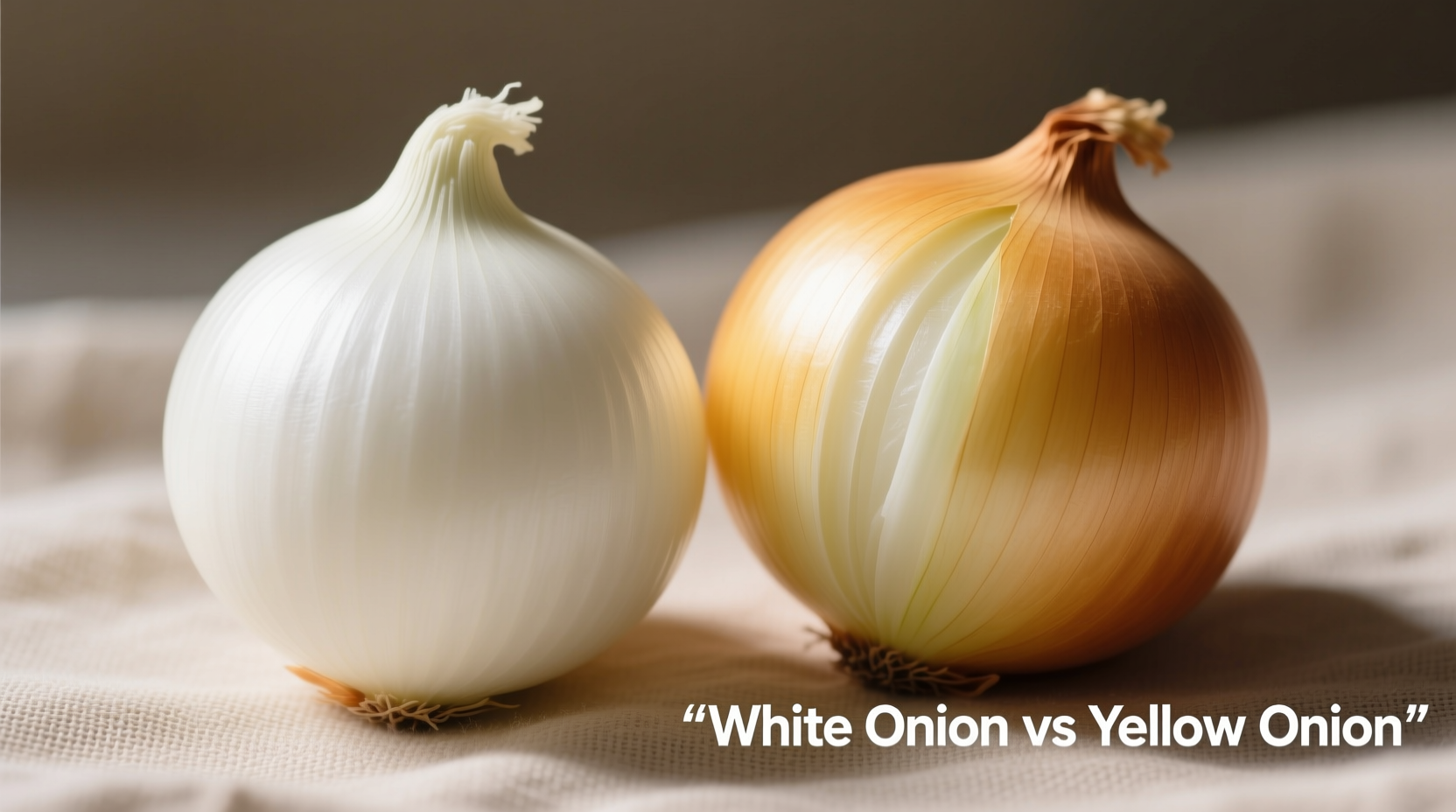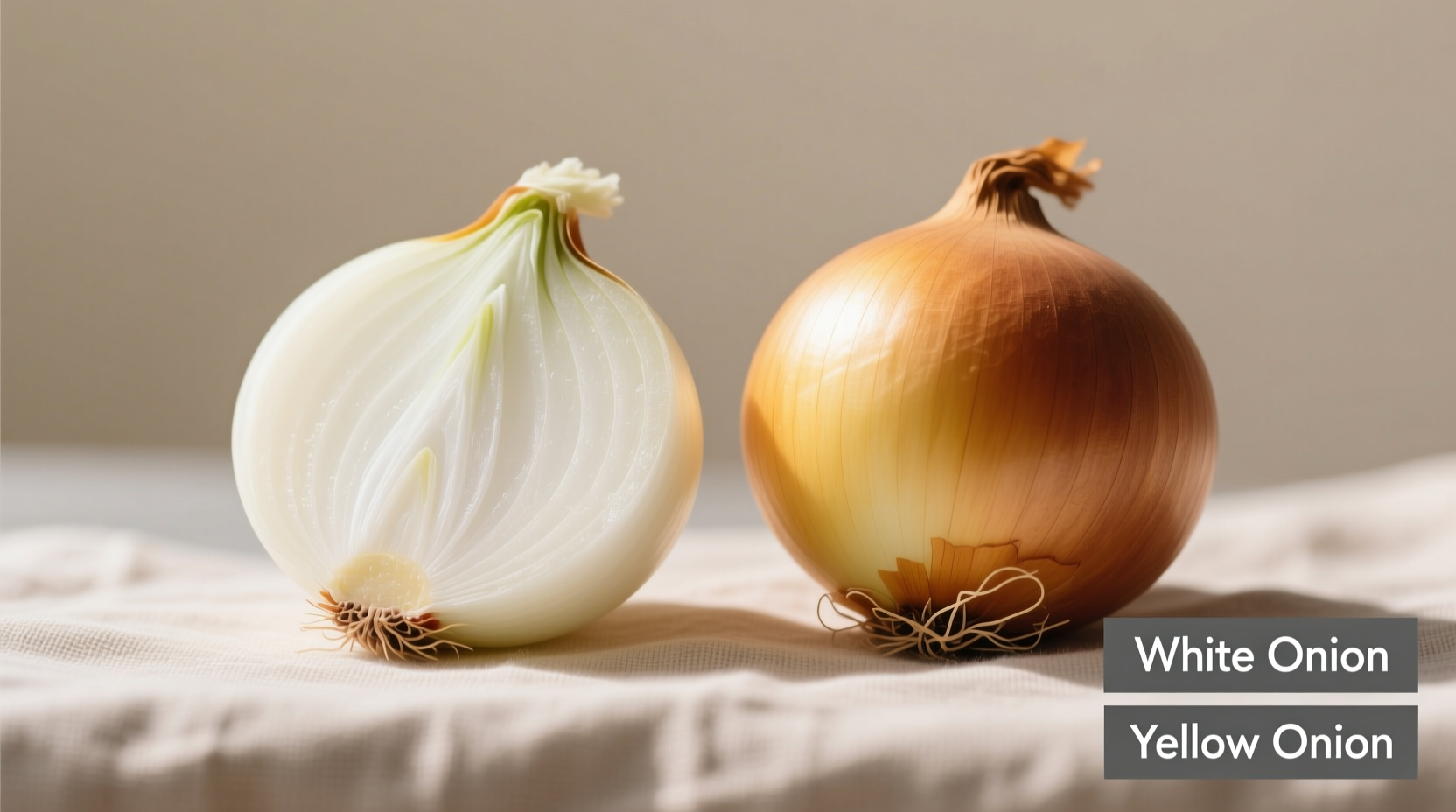Ever stood in the grocery store produce section wondering whether to grab white onions or yellow onions for your recipe? You're not alone. This practical guide cuts through the confusion with actionable insights from professional kitchen experience. After 15 years teaching home cooks how to maximize flavor, I've seen how understanding these onion varieties transforms ordinary meals into extraordinary ones.

Physical and Flavor Differences at a Glance
Before we dive into specific cooking applications, let's examine the fundamental differences between these two onion varieties. While they may look similar at first glance, their chemical composition creates distinct culinary behaviors that significantly impact your dishes.
| Characteristic | White Onion | Yellow Onion |
|---|---|---|
| Outer Skin | Pale, paper-thin skin | Thicker, brownish-gold skin |
| Inner Flesh | Bright white, crisp texture | Yellowish-white, slightly denser |
| Raw Flavor Profile | Sharp, pungent, clean bite | Stronger sulfur notes, more intense heat |
| Cooked Flavor Profile | Milder when cooked, retains some sharpness | Develops rich sweetness, caramelizes beautifully |
| Water Content | Higher moisture content | Slightly lower moisture content |
| Shelf Life | 2-3 weeks refrigerated | 4-6 weeks in cool, dark place |
When Raw Applications Matter Most
Raw onion applications represent the most significant difference between these varieties. White onions maintain their crisp texture and deliver a cleaner, more immediate bite that doesn't overwhelm other fresh ingredients. This makes them the preferred choice for:
- Mexican salsas and pico de gallo where texture and fresh flavor are critical
- Ceviche and other raw fish preparations
- Fresh salads where you want onion presence without excessive heat
- Garnishes for tacos and grilled meats
According to USDA agricultural research data, white onions contain slightly different sulfur compounds that create their distinctive sharp-but-clean flavor profile when raw. This chemical composition makes them less likely to turn dishes brown or create off-flavors in acidic preparations like lime-based salsas.
Cooking Transformation: How Heat Changes Everything
When subjected to heat, yellow onions undergo a remarkable transformation that white onions can't match. The higher sugar content in yellow onions (approximately 4-5% more natural sugars according to University of California agricultural studies) creates that beloved caramelized sweetness essential to so many dishes.
Professional chefs consistently reach for yellow onions when making:
- French onion soup (the classic choice for deep caramelization)
- Onion confit and marmalades
- Beef bourguignon and other braised meat dishes
- Gravy bases and roux foundations
- Roasted vegetable medleys
While white onions can be used in cooked applications, they don't develop the same depth of flavor. Their higher water content means they take longer to caramelize and often result in a slightly more acidic finished product.
Smart Substitution Guide: When You Can Swap and When You Shouldn't
Running out of your preferred onion variety doesn't have to ruin your meal, but knowing the substitution boundaries prevents flavor disasters. Consider these practical guidelines:
Safe Substitutions
When cooking dishes that require long simmering or roasting, yellow and white onions can often be interchanged with minimal impact. The extended cooking time allows both varieties to mellow and develop similar flavor bases.
When Substitutions Fail
Avoid substituting when:
- Making fresh salsas or pico de gallo (white onions maintain better texture)
- Creating delicate ceviche (yellow onions can overpower with stronger sulfur notes)
- Preparing traditional French onion soup (yellow onions provide essential caramelization)
- Using in raw applications where appearance matters (white onions won't discolor other ingredients)
Food science research from Cornell University's Food and Brand Lab confirms that the visual presentation of dishes suffers when using yellow onions in raw applications due to their tendency to leach color into surrounding ingredients.
Storage Secrets for Maximum Freshness
Proper storage significantly extends the usability of both onion varieties, but their different compositions require slightly different approaches:
- White onions: Store in the refrigerator crisper drawer in a mesh bag. Their higher moisture content makes them more perishable at room temperature.
- Yellow onions: Keep in a cool, dark, well-ventilated space like a pantry. Their thicker skin provides better protection against moisture loss.
- Never store either variety near potatoes, which release gases that accelerate onion spoilage.
- Once cut, both varieties should be sealed in airtight containers and refrigerated for up to 7 days.
Nutritional Comparison: More Than Just Flavor
Both onion varieties offer significant health benefits, with minor differences that might influence your choice:
- Yellow onions contain slightly higher levels of quercetin, a powerful antioxidant
- White onions provide marginally more allicin, the compound responsible for many of onions' health benefits
- Both are excellent sources of vitamin C, B vitamins, and dietary fiber
- Nutritionally, the differences are minimal - choose based on flavor needs rather than health considerations
Research published in the Journal of Agricultural and Food Chemistry confirms that cooking affects the bioavailability of these compounds differently in each onion variety, with yellow onions showing greater retention of beneficial compounds during extended cooking.
Professional Chef Tips for Maximum Flavor
After years working in professional kitchens, I've developed these practical techniques to get the most from each onion variety:
- For raw applications: Soak white onions in cold water for 10-15 minutes to mellow the sharpness without losing crunch
- When caramelizing yellow onions: Start with low heat and patience—proper caramelization takes 30-45 minutes for optimal sweetness
- For layered flavor: Combine both varieties in dishes requiring both raw and cooked elements (like a stew with raw garnish)
- Never use a food processor for caramelizing onions—the high speed creates uneven texture and prevents proper browning
Final Verdict: Which Onion Belongs in Your Kitchen?
Both white and yellow onions deserve a place in your kitchen, but understanding their distinct personalities ensures perfect results. Keep white onions for fresh applications where crisp texture and clean flavor matter most. Stock yellow onions as your versatile cooking workhorse that transforms with heat into sweet, complex flavor foundations.
Remember: The best cooks don't just follow recipes—they understand ingredients. By recognizing these subtle but significant differences between white and yellow onions, you'll make more informed decisions that elevate every dish you create.











 浙公网安备
33010002000092号
浙公网安备
33010002000092号 浙B2-20120091-4
浙B2-20120091-4